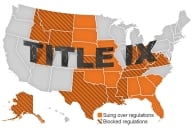You have /5 articles left.
Sign up for a free account or log in.
In this post, I have two goals. My first objective is to continue a discussion that I kicked off about Vijay Gurbaxani's recent Forbes piece "Will COVID-19 Save Higher Education?"
In "Why Behaving Like Big Tech Will Not 'Save' Higher Education," I used Gurbaxani's Forbes article to riff on the idea that the software industry offers a suboptimal model for postsecondary reform.
My second goal in this piece is, with Gurbaxani, to model the use of social media (blog posts and tweets) for collegial social media academic debate. I'll do this by copying Gurbaxani's tweeted responses to my blog post.
What I hope will be clear is that our exchange is both public and respectful. I don't know Gurbaxani personally, but I know that we will have lots to talk about if and when we meet. Mostly, I'm confident that if I met Gurbaxani that I'd learn much by listening to what he has to say and that we would listen carefully to each other.
Social media does not customarily foster collegial and respectful debate. If we want to take advantage of the fast and public platforms that social media can provide for academic conversations, then it is up to all of us to try to use these platforms as Gurbaxani has modeled.
Here are Gurbaxani's tweets related to my article, cut and pasted in reverse order so you can read them chronologically:









How would I respond to Gurbaxani?
First, I'd like to own up to the truth that what Gurbaxani was arguing in his Forbes piece is that colleges and universities adopt software thinking rather than model their operations on software companies. There is little space in a short article to unpack the distinctions between software thinking and software company operations and then relate all this back to higher education leadership during a pandemic. I hope that Gurbaxani builds on this line of thinking in future writing.
If Gurbaxani does decide to write more about higher ed, I only ask that he takes the time and effort to contextualize his ideas within the broader conversation about educational technology and postsecondary innovation.
Gurbaxani will find that there is a long history of critics of higher education emphasizing technological fixes and management solutions drawn from for-profit industries as solutions to the challenges of colleges and universities. There is a persistent idea that if only higher education could be more flexible and more agile -- in effect, more like tech start-ups -- that the sector's access and cost and quality issues would disappear.
This critique of higher education seldom grapples with the realities of the systematic disinvestment in the public institutions that educate six in 10 students. Nor does this critique acknowledge the structural inequalities that funnel a disproportionate amount of resources into flagship public universities, at the expense of mission-driven community colleges and other public institutions.
Critiques of wealthy and highly selective colleges and universities are more than welcome. A strong case can be made that our nation's most highly ranked colleges and universities are doing more to perpetuate and deepen social and economic inequalities than to ameliorate them.
Going forward, I hope that Gurbaxani applies his analytical lens to postsecondary innovation while being sensitive to the history of using technological and business thinking to justify public disinvestment and growing levels of higher education inequality.








